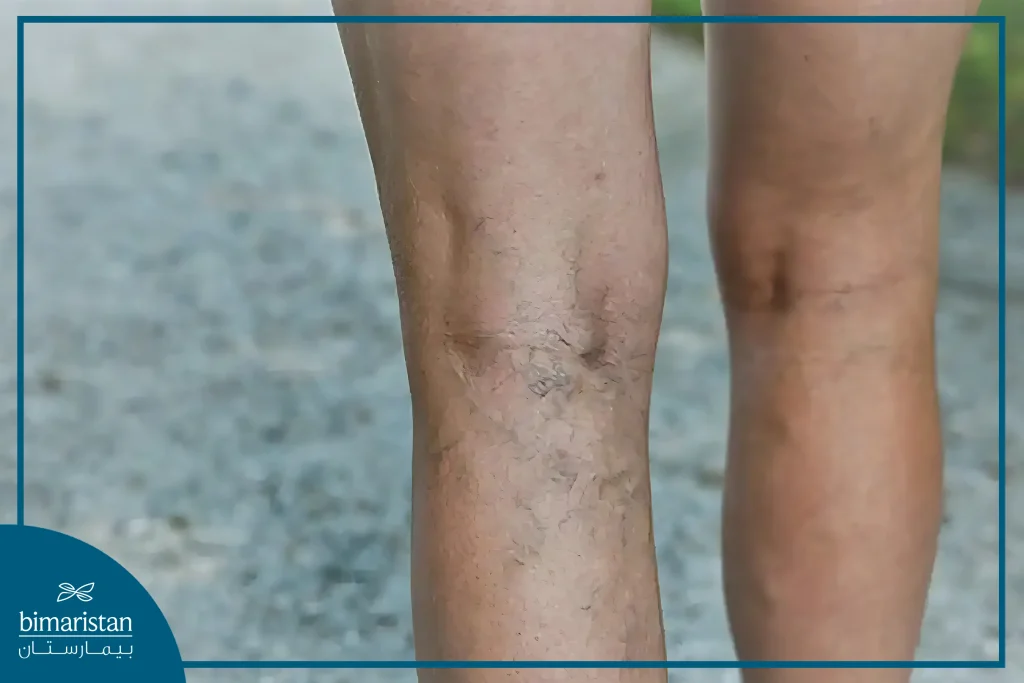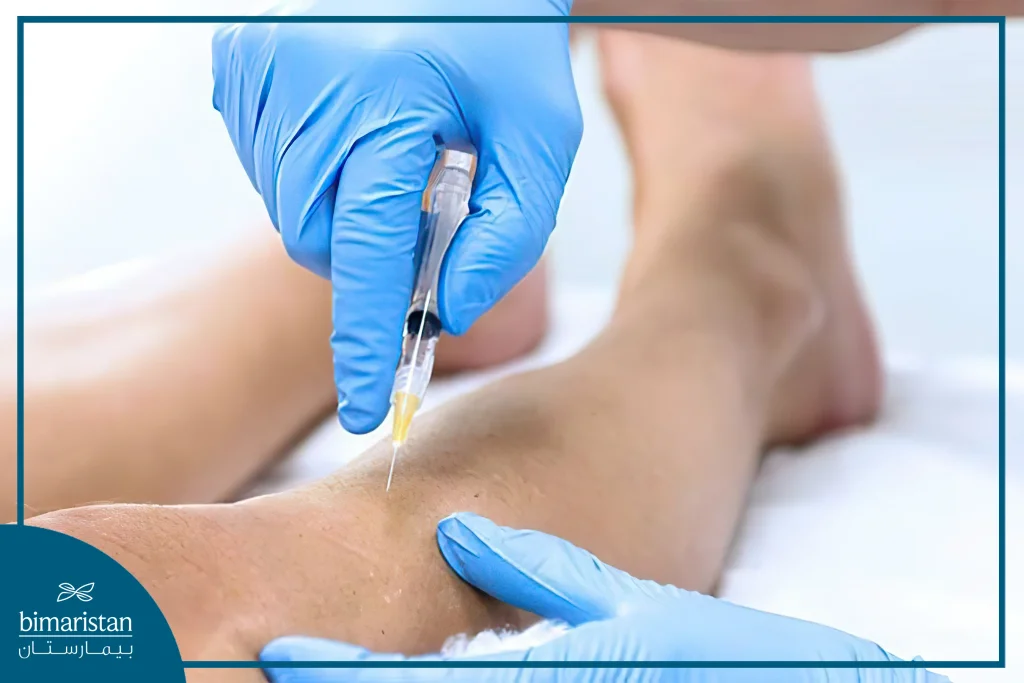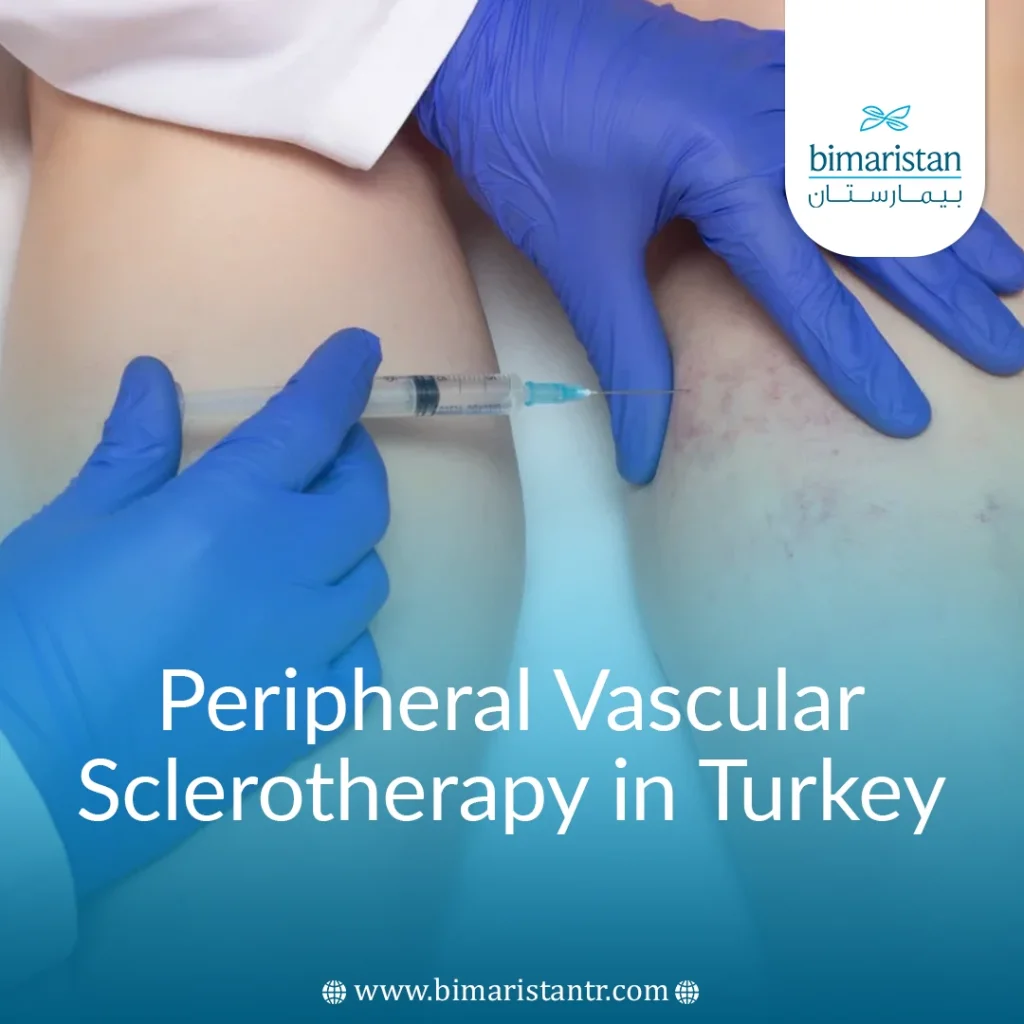Small to medium-sized varicose veins in the legs can be treated with a simple procedure that yields excellent and lasting results, in addition to treating spider veins. Learn about the methods of treating varicose veins with peripheral vascular sclerotherapy in Turkey, including its advantages, disadvantages, and who it is suitable for.
When you decide it’s time to get rid of spider or varicose veins, vein sclerotherapy is one of the best treatment options. Sclerotherapy is a simple procedure that takes less than an hour, and you can return to your daily activities immediately after treatment.
Over the past ten years, medical practice has significantly changed. Many new minimally invasive treatment techniques have been developed and implemented. The main goal of these advancements is to avoid surgical removal of varicose veins, eliminate the need for general anesthesia, and prevent incisions in the legs and hospitalization, leading to quicker recovery. Foam injections for varicose veins guided by radiofrequency have become a method to achieve long-term treatment of varicose veins.
What are varicose veins?
It is believed that incompetent one-way valves in the leg veins and weak vein walls cause the dilation of veins, leading to the formation of varicose veins. Blood cannot flow effectively back to the heart and instead remains in the veins, usually in the legs. As it accumulates in the leg veins, the veins enlarge, forming varicose veins. Not everyone with varicose veins requires treatment.

Who are the candidates for peripheral vascular sclerotherapy?
Symptoms that may require treatment include:
- Discomfort in the legs
- Leg swelling
- Itching
- A burning or throbbing sensation
- Skin thickening
- Non-healing leg ulcers
- Previous blood clots
- Varicose vein bleeding
Varicose vein treatment options
Lifestyle changes should be tried before undergoing surgery, sclerotherapy, laser treatment, or any other varicose vein treatment method.
Lifestyle changes are adjustments you can make to your way of living and generally do not require medical intervention. These include weight loss, exercising, elevating your legs, and wearing special stockings.
After taking a medical history and performing a physical examination, a vascular specialist will use imaging to assess blood flow and the structure of the leg veins before recommending the appropriate varicose vein treatment. In the past, highly invasive surgical treatments were the only options available for removing varicose veins.
Vein stripping is a procedure in which the surgeon removes varicose veins through incisions. It is not the most preferred option due to the number of incisions usually required and the lengthy recovery time.
However, varicose vein specialists now offer new options like laser treatment, which has replaced older surgical methods. Some of the best modern treatments for varicose veins include:
- Laser Varicose Vein Removal—The FDA has approved a minimally invasive procedure for laser varicose vein treatment using radiofrequency-guided laser technology. It provides immediate results and requires minimal recovery time. After administering local anesthesia, the varicose vein specialist inserts a small catheter into the vein with radiofrequency guidance. This is followed by a small laser fiber, which delivers gentle laser energy, causing the vein to close. The procedure takes only about 10 minutes and does not require hospitalization.
- Sclerotherapy for Varicose Veins—During this procedure, the varicose vein specialist uses a fine needle to inject an FDA-approved sclerosing agent into the vein. This effective medication causes the vein to close. Over time, the body absorbs the closed vein, and it disappears. Sessions are typically completed in the clinic in about 20 minutes per leg.
When it’s time to seek treatment, a vascular specialist experienced in treating varicose veins, spider veins, and other symptoms of chronic venous insufficiency can use the latest techniques in vein removal and sclerotherapy.
Since neither scalpels nor sutures are used in either treatment, there are no long-term scars or keloids.
There is minimal discomfort, and most treatments are virtually painless. Most people can resume their daily activities immediately after treatment.
What is peripheral vascular sclerotherapy?
Vein sclerotherapy is used to treat varicose veins and “spider veins.” During sclerotherapy, the doctor injects a solution directly into the affected vein. The solution irritates the vessel’s lining, causing it to swell and stick together. Over time, the vessel turns into scar tissue that fades from view. Sclerotherapy is a well-established procedure that has been used since the 1930s.

How effective is sclerotherapy for treating spider veins and varicose veins?
Sclerotherapy is adequate for most patients. It is estimated that between 50% and 80% of the injected vein can be eliminated in each session. However, a small percentage of people (less than 10%) who undergo sclerotherapy do not respond to the injections at all. In such cases, different solutions or alternative treatments, such as laser therapy, can be tried.
Small varicose veins (spider veins) respond to treatment within 3 to 6 weeks, while larger varicose veins may take 3 to 4 months to respond. If the veins respond to treatment, they usually do not reappear. However, new veins may form over time; if necessary, you can return for additional vein injections for varicose veins.
Sclerotherapy injection substance
Polidocanol is a sclerosing agent sold under the trade names Asclera, Ethoxysclerol, and Varithena. This substance induces fibrosis within the varicose veins, leading to the closure of the internal lumen, thereby reducing the appearance and symptoms of varicose veins.
The FDA has approved the use of polidocanol injections for treating spider veins (1 to 3 mm in diameter) and small varicose veins (less than 1 mm in diameter).
Am I a candidate for sclerotherapy?
Before the procedure, you will meet with a vascular specialist to evaluate your eligibility for sclerotherapy.
You are not eligible for sclerotherapy if you are pregnant, breastfeeding, or bedridden. You should wait at least three months after giving birth before considering this procedure.
You can undergo sclerotherapy if you are taking birth control pills. If you have had a blood clot in the past, eligibility will depend on the cause and severity of the clot.
Sclerotherapy procedure details
How is sclerotherapy for varicose veins performed?
Sclerotherapy is performed in the doctor’s office. The treatment area is cleansed, and the solution is injected directly into the blood vessels using very fine needles.
The number of veins injected in one session depends on their size, location, and the patient’s overall medical condition. When a larger vein is injected, you may experience mild discomfort and a cramping sensation for 1-2 minutes.
Preparation before sclerotherapy
Preparation for vein sclerotherapy includes several guidelines. Here are a few:
Medications: Before vein sclerotherapy, certain medications should be avoided. Please follow these guidelines:
- Tetracycline or Minocin: These antibiotics can cause skin sensitivity if taken 7 to 10 days before or after sclerotherapy. Consult your doctor about alternative antibiotics or safe guidelines for stopping these medications. If you need to take an antibiotic before any surgical procedure, such as dental work, colonoscopy, or surgery, inform your doctor.
- Aspirin and other anti-inflammatory medications: Do not take aspirin or other anti-inflammatory medications 48 hours before and after sclerotherapy, as these may interfere with the action of the sclerosing agent or increase bleeding. Tylenol® is permitted. Consult your doctor for specific instructions before stopping any medication.
- Prednisone: This medication makes the sclerosing agent less effective. Ask the doctor who prescribed prednisone if it can be safely stopped 48 hours before sclerotherapy.
Other Pre-Sclerotherapy Guidelines
- Do not apply any lotion to your legs before or after sclerotherapy.
- We recommend bringing a pair of shorts to wear during the procedure.
- If you have compression stockings from previous varicose vein treatments, please bring them to ensure they provide adequate support after the procedure.
How long does sclerotherapy take?
Sclerotherapy takes about 30 minutes to an hour.
What happens after sclerotherapy?
After the varicose injection, you can drive home and resume regular activities. Walking is encouraged.
Your doctor will instruct you to wear compression stockings to apply pressure to the treated veins. Ensure your compression stockings are effective, and consult your doctor about them.
For 48 hours after the procedure, follow these guidelines:
- Avoid aspirin, ibuprofen, and other anti-inflammatory medications. Tylenol® may be used if needed for pain relief.
- Do not take hot baths or sit in hot tubs or saunas. Showering is allowed, but the water should be cooler than usual.
- Wash injection sites with mild soap and lukewarm water.
- Do not apply hot compresses or any form of heat to the treated areas.
- Avoid direct exposure to sunlight.
Contact your doctor for any concerns or questions after the varicose injection.
Ultrasound-guided sclerotherapy (UGS) is a highly specialized procedure for treating advanced varicose veins hidden beneath the skin.
This very effective method involves injecting a sclerosing solution into the enlarged veins under radiofrequency guidance, causing the vein wall to collapse. The veins gradually dissolve and disappear as the body absorbs them.
How is ultrasound-guided sclerotherapy performed?
A detailed ultrasound examination is performed before the procedure to create a virtual map of the leg veins. This map accurately displays all abnormal veins and surrounding structures, such as deep veins and arteries, helping the vein specialist identify the cause of visible varicose veins.
After the ultrasound examination, the patient lies comfortably on the treatment bed with their legs exposed. Using ultrasound guidance, the doctor can precisely direct the needle and inject the hidden abnormal veins while monitoring the process on the screen.
Once injected, the treated vessel collapses and is gradually absorbed by the body, disappearing over time. Multiple injections along the vein may be required to achieve complete closure.
One significant advantage of this method is that it allows the vascular specialist to monitor the effect of each injection while ensuring the safety of all surrounding structures. Using the sclerosing agent in foam form rather than a solution has made this procedure more effective.
What happens after ultrasound-guided sclerotherapy?
The treatment typically takes about half an hour, but an hour is allocated to allow time for the ultrasound examination and to explain the procedure to the patient. After the procedure, you will receive grade 2 graduated compression stockings and be instructed to walk for 30-40 minutes to promote blood flow to the deep veins.
A follow-up appointment is usually scheduled a week after vein sclerotherapy. At this appointment, the doctor will perform another ultrasound to ensure the sclerotherapy was successful and treat any remaining spider or varicose veins using microsclerotherapy techniques.
Side effects of sclerotherapy for varicose veins
Possible side effects of vein sclerotherapy include:
- The injected veins may become lumpy or hard for several months before they improve.
- Raised red areas at injection sites should disappear within a few days.
- Brown lines or spots on the skin at the injection site, possibly caused by iron leaking from the blood in the injected veins. In most cases, these disappear within 3 to 6 months, but about 5% of cases remain permanent.
- Bruising around the injection site can last several days or weeks.
- Small temporary blood vessels may develop in the treated area, known as telangiectatic matting or “blushing.” These may appear days or weeks after sclerotherapy but should fade within a few months and usually do not require further treatment.
- Allergic reactions to the sclerosing agent may occur during injection and are rarely severe. Symptoms include itching and swelling.
Causes of bruising after sclerotherapy
Bruising and localized pigmentation at the injection site after vein sclerotherapy are common, often due to inflammation from the sclerosing agent. These symptoms are usually temporary (typically resolving within 6-12 weeks). A few patients may experience prolonged symptoms up to a year after treatment. If the condition worsens or shows no signs of improvement over several weeks, follow up with your doctor.
Other side effects are uncommon after sclerotherapy. If you experience any of the following rare side effects, contact your doctor immediately:
- Inflammation (swelling) in the groin
- Sudden swelling in the leg
- Small ulcers at the injection site
- A red streak, especially in the thigh area
What are the results of ultrasound-guided foam sclerotherapy?
Studies show that 80-90% of veins remain closed permanently after sclerotherapy when examined with ultrasound five years later. This success rate is similar to other newer techniques. Clinical trials comparing surgery, foam injections for varicose veins, laser ablation, and radiofrequency ablation found that the results assessed clinically and reported by patients were identical.
Advantages of sclerotherapy
- Avoidance of vein surgery with no discomfort after sclerotherapy.
- Significantly fewer bruises than surgery.
- There is no need for general anesthesia, leg incisions, hospitalization, or an operating room.
- No scarring.
- Retreatment of other varicose veins is simple.
- Less expensive than surgical treatment.
- There is no need for time off work after sclerotherapy.
Disadvantages of sclerotherapy
- Mild leg discomfort may last for 2-4 weeks after sclerotherapy.
- Mild bruising and some lumps may persist for several weeks after sclerotherapy. However, these two symptoms are also complications of surgical treatment for varicose veins.
- Sclerotherapy’s final result may take several months to develop, while varicose vein surgery’s results are faster.
References:
- Sclerotherapy for venous malformations, Oxford Radcliffe Hospital.
- Sclerotherapy complications of peripheral venous malformation, Phlebology.

